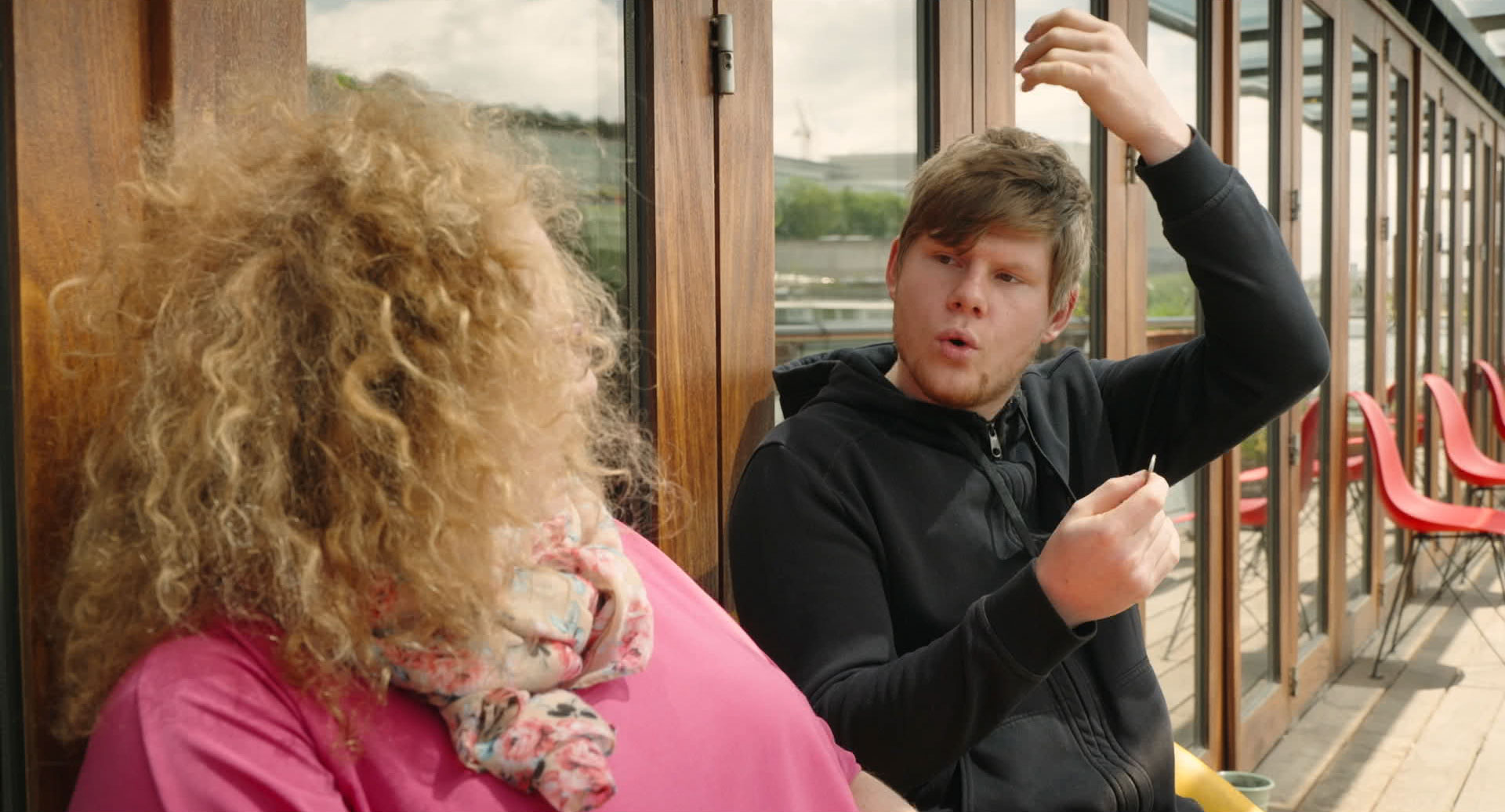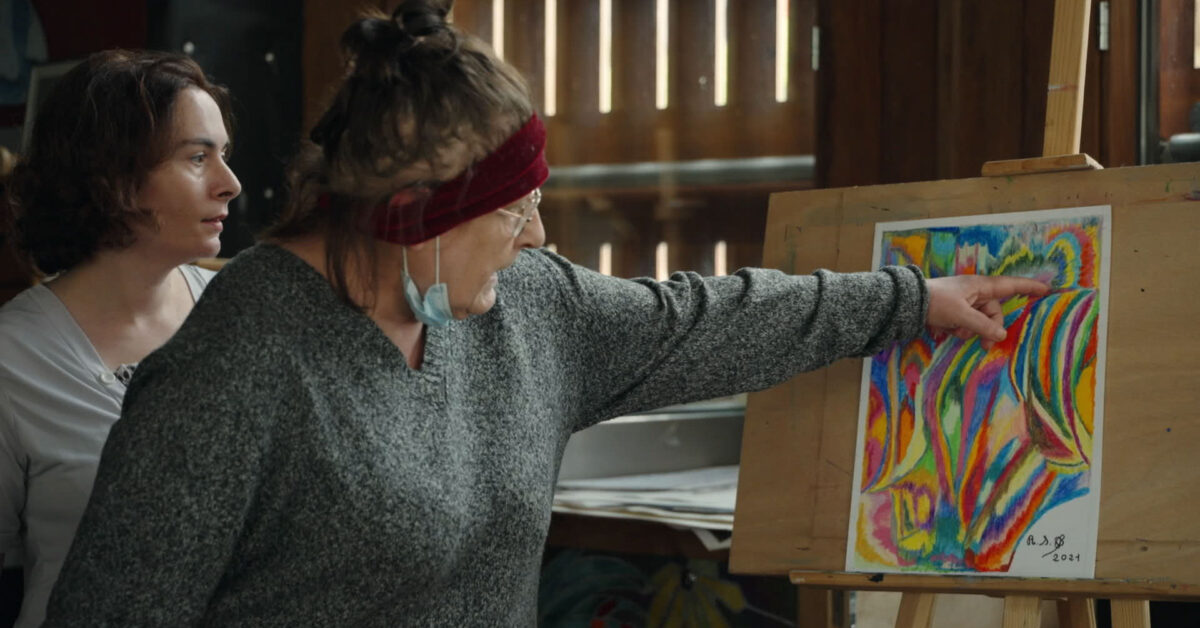Director Nicolas Philibert belongs to the “fly on the wall” school of documentary filmmaking, meaning he turns his camera on and lets it roll, capturing life as it unfolds around him. He also tends to focus on a single location that has something to teach him—and his audience—about humanity, exploring a demographic that has piqued his curiosity. In the Land of the Deaf takes place in a French school for the deaf. In his Louis Delluc Prize and César Award-winning To Be and To Have, he documented the day-to-day lives of the teacher and students at a one-room school house in rural France.
For his stunning eleventh film, On the Adamant, the 72-year-old director immersed himself in le Centre de jour l’Adamant, a treatment center for adults with mental disabilities that floats on the Seine in the middle of Paris. Patients drop in as often as they like to read, draw, play music, make jam, and help run the café. The wide range of educational activities, most grounded in the arts, let the patients explore their own personal stories through their creativity—and also just make art, have fun, be a part of a community. Sun glistens on the water outside. Inside, coffee boils in a café. Groups of people socialize. Sometimes a man in the corner, a patient, plays guitar—very well. The jury of the 2023 Berlin Film Festival, overseen by Kristen Stewart, awarded the festival’s top prize, the Golden Bear, to this extraordinary—and extraordinarily moving—film.

The film opens with Philippe, a man in his late 50s, belting out “La bombe humaine,” a 1979 song by French rock band, Telephone, in the corner of the café, a guitarist backing him up. “You hold the human bomb in your hand/The trigger is right next to your heart,” he sings, “The human bomb is you/It belongs to you.”
Passion oozes from Philippe’s pores. With his grizzled jaw and throaty voice, he looks and sounds like an aging rockstar. He is missing a lot of his teeth, you might notice, and remember that this is a film about mental health. It slowly dawns on you: Wait, is he a patient? One brilliant element of the film is that we can’t always tell. The therapists and other staff wear street clothes. In many scenes of a group working on an art project or discussing upcoming events, we ask ourselves which are the patients and which the staff? Everyone in the room appears calm and capable. In most cases, no one is an obvious caregiver or therapist or teacher. They’re all hanging out. Occasionally a visible tic tips us off to a disability, but more often than not, we get to know the characters by watching them draw or sew or count piles of change. Philibert does conduct interviews with the patients, allowing them to speak about their lives and letting the audience step into their minds, which is a fascinating place to be. Someone talks, their stream of consciousness often revealing just how troubled they are. Most are eager to share their stories and life philosophies. They are clearly comfortable in this environment and with Philibert, who spent months filming at l’Adamant.

Philibert wants us to understand that these patients are individuals with their own perspectives and back stories. His gaze is compassionate. In some of the interviews, the subjects talk about their illness head-on, their therapy, the medication that allows them to function. Philippe, the singer from the opening scene, says he’s struggled with mental illness since he was a teenager, and admits if he didn’t take his meds, he would rave and think he was Jesus. “I’m unbearable without my medication,” he says. “I would throw myself into the Seine.”
L’Adamant is unlike other care facilities. The fact that we might mistake Philippe for a professional musician performing in a bar is the point. The patients engage in pursuits that rev up their passions, many of them creative, and their confidence. Through the art they create, patients explore the stories of their lives and share them with each other and the facilitating therapists and staff. They also have something to do and someplace to be where they are treated with dignity and respect.

One man, the eloquent and entertaining Frederic, writes and records songs inspired by the tragic lives of Jim Morrison and James Dean. “I want to find out why tragic things happen to us,” he says. (He also believes the characters in the film Paris, Texas are based on him and his brother, a fact unacknowledged by director Wim Wenders.) Another man draws a picture he says depicts his two young daughters. At the weekly Monday meeting, patients discuss a film festival they’re planning to celebrate the 10th anniversary of their Cinema Club, for which the patients will select the films, including 8 ½ by Federico Fellini, Through the Olive Trees by Abbas Kiarostami, and Day for Night by François Truffaut, which will be followed by a discussion led by Frederic, the same soulful patient who channels Jim Morrison in his compositions.

Every activity is an opportunity to function and interact with people normally in the world. The program seems to work. The patients don’t have to be there. They choose to, and many of them come back day after day.
Between the extreme beauty of the facility, with its deep brown wooden exterior and bay windows that open out onto the river, the focus on art as therapy, and the practice of giving the patients responsibility and treating them with respect, the picture Philibert paints is idyllic. We view the pateints’ artwork, some so lovely we could imagine hanging it in our homes. And throughout the film, these men and women who exist on the fringe of society are treated like human beings. They are given adult tasks. Their opinions are taken seriously. L’Adamant appears as a therapeutic utopia, a beacon for the rest of the world to look upon and aspire to, if only there were enough resources and political will to help a population so often dismissed. Instead, in most places, people like the ones we meet in the film are hidden away and recognized only for their potentially violent impulses and acts. The film challenges this practice and invites us to wonder what might happen if compassion and dignity were society’s driving forces?
On the Adamant opens in New York on March 29. A national expansion will follow.
Andrea Meyer has written creative treatments for commercial directors, a sex & the movies column for IFC, and a horror screenplay for MGM. Her first novel, Room for Love (St. Martin’s Press) is a romantic comedy based on an article she wrote for the New York Post, for which she pretended to look for a roommate as a ploy to meet men. A long-time film and entertainment journalist and former indieWIRE editor, Andrea has interviewed more actors and directors than she can remember. Her articles and essays have appeared in such publications as Elle, Glamour, Variety, Time Out NY, and the Boston Globe.






